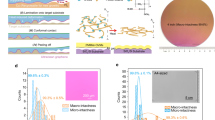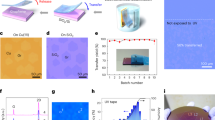Abstract
Metal–semiconductor junctions are essential components in electronic and optoelectronic devices. With two-dimensional semiconductors, conventional metal deposition via ion bombardment results in chemical disorder and Fermi-level pinning. Transfer printing techniques—in which metal electrodes are predeposited and transferred to create van der Waals junctions—have thus been developed, but the predeposition of metal electrodes creates chemical bonds on the substrate, which makes subsequent transfer difficult. Here we report a graphene-assisted metal transfer printing process that can be used to form van der Waals contacts between two-dimensional materials and three-dimensional metal electrodes. We show that arrays of metal electrodes with both weak (copper, silver and gold) and strong (platinum, titanium and nickel) adhesion strengths can be delaminated from a four-inch graphene wafer due to its weak van der Waals force and absence of dangling bonds, and transfer printed onto different substrates (graphene, molybdenum disulfide and silicon dioxide). We use this approach to create molybdenum disulfide field-effect transistors with different printed metal electrodes, allowing the Schottky barrier height to be tuned and ohmic and Schottky contacts to be formed. We also demonstrate the batch production of molybdenum disulfide transistor arrays with uniform electrical characteristics.
This is a preview of subscription content, access via your institution
Access options
Access Nature and 54 other Nature Portfolio journals
Get Nature+, our best-value online-access subscription
$29.99 / 30 days
cancel any time
Subscribe to this journal
Receive 12 digital issues and online access to articles
$119.00 per year
only $9.92 per issue
Buy this article
- Purchase on Springer Link
- Instant access to full article PDF
Prices may be subject to local taxes which are calculated during checkout




Similar content being viewed by others
Data availability
Source data are provided with this paper. The data that support the plots within this paper and other findings of this study are available from the corresponding authors upon reasonable request.
References
Schulman, D. S., Arnold, A. J. & Das, S. Contact engineering for 2D materials and devices. Chem. Soc. Rev. 47, 3037–3058 (2018).
Allain, A., Kang, J. H., Banerjee, K. & Kis, A. Electrical contacts to two-dimensional semiconductors. Nat. Mater. 14, 1195–1205 (2015).
Mleczko, M. J. et al. Contact engineering high-performance n-type MoTe2 transistors. Nano Lett. 19, 6352–6362 (2019).
Cho, K. et al. Contact-engineered electrical properties of MoS2 field-effect transistors via selectively deposited thiol-molecules. Adv. Mater. 30, e1705540 (2018).
Wang, T. et al. High-performance WSe2 phototransistors with 2D/2D ohmic contacts. Nano Lett. 18, 2766–2771 (2018).
Cui, X. et al. Low-temperature ohmic contact to monolayer MoS2 by van der Waals bonded Co/h-BN electrodes. Nano Lett. 17, 4781–4786 (2017).
Kappera, R. et al. Phase-engineered low-resistance contacts for ultrathin MoS2 transistors. Nat. Mater. 13, 1128–1134 (2014).
Kim, G. S. et al. Schottky barrier height engineering for electrical contacts of multilayered MoS2 transistors with reduction of metal-induced gap states. ACS Nano 12, 6292–6300 (2018).
Wang, Y. et al. Van der Waals contacts between three-dimensional metals and two-dimensional semiconductors. Nature 568, 70–74 (2019).
Bampoulis, P. et al. Defect dominated charge transport and Fermi level pinning in MoS2/metal contacts. ACS Appl. Mater. Interfaces 9, 19278–19286 (2017).
McDonnell, S., Addou, R., Buie, C., Wallace, R. M. & Hinkle, C. L. Defect-dominated doping and contact resistance in MoS2. ACS Nano 8, 2880–2888 (2014).
Dagan, R., Vaknin, Y. & Rosenwaks, Y. Gap state distribution and Fermi level pinning in monolayer to multilayer MoS2 field effect transistors. Nanoscale 12, 8883–8889 (2020).
Addou, R., Colombo, L. & Wallace, R. M. Surface defects on natural MoS2. ACS Appl. Mater. Interfaces 7, 11921–11929 (2015).
Sotthewes, K. et al. Universal Fermi-level pinning in transition-metal dichalcogenides. J. Phys. Chem. C 123, 5411–5420 (2019).
Kim, C. et al. Fermi level pinning at electrical metal contacts of monolayer molybdenum dichalcogenides. ACS Nano 11, 1588–1596 (2017).
Das, S., Chen, H. Y., Penumatcha, A. V. & Appenzeller, J. High performance multilayer MoS2 transistors with scandium contacts. Nano Lett. 13, 100–105 (2013).
Gong, C., Colombo, L., Wallace, R. M. & Cho, K. The unusual mechanism of partial Fermi level pinning at metal–MoS2 interfaces. Nano Lett. 14, 1714–1720 (2014).
Liu, Y. et al. Approaching the Schottky–Mott limit in van der Waals metal–semiconductor junctions. Nature 557, 696–700 (2018).
Shim, J. et al. Controlled crack propagation for atomic precision handling of wafer-scale two-dimensional materials. Science 362, 665–670 (2018).
Kang, K. et al. High-mobility three-atom-thick semiconducting films with wafer-scale homogeneity. Nature 520, 656–660 (2015).
Kang, K. et al. Layer-by-layer assembly of two-dimensional materials into wafer-scale heterostructures. Nature 550, 229–233 (2017).
Yuan, G. et al. Proton-assisted growth of ultra-flat graphene films. Nature 577, 204–208 (2020).
Chen, J. et al. Synthesis of wafer-scale monolayer WS2 crystals toward the application in integrated electronic devices. ACS Appl. Mater. Interfaces 11, 19381–19387 (2019).
Chubarov, M. et al. Wafer-scale epitaxial growth of unidirectional WS2 monolayers on sapphire. ACS Nano 15, 2532–2541 (2021).
Wang, Q. et al. Wafer-scale highly oriented monolayer MoS2 with large domain sizes. Nano Lett. 20, 7193–7199 (2020).
Kum, H. S. et al. Heterogeneous integration of single-crystalline complex-oxide membranes. Nature 578, 75–81 (2020).
Kim, Y. et al. Remote epitaxy through graphene enables two-dimensional material-based layer transfer. Nature 544, 340–343 (2017).
Wang, T. et al. Wafer-scale fabrication of single-crystal graphene on Ge(110) substrate by optimized CH4/H2 ratio. Appl. Surf. Sci. 529, 147066 (2020).
Lee, J. H. et al. Wafer-scale growth of single-crystal monolayer graphene on reusable hydrogen-terminated germanium. Science 344, 286–289 (2014).
Yoon, H. H. et al. Strong Fermi-level pinning at metal/n-Si(001) interface ensured by forming an intact Schottky contact with a graphene insertion layer. Nano Lett. 17, 44–49 (2017).
Lafontaine, W. R. & Li, C. Y. Hardness and adhesion measurements of copper metallizations by a continuous indentation approach. MRS Proc. 203, 163–168 (1990).
Jung, Y. et al. Transferred via contacts as a platform for ideal two-dimensional transistors. Nat. Electron. 2, 187–194 (2019).
Noh, J. Y., Kim, H. & Kim, Y. S. Stability and electronic structures of native defects in single-layer MoS2. Phys. Rev. B 89, 205417 (2014).
Lee, C. H. et al. Atomically thin p–n junctions with van der Waals heterointerfaces. Nat. Nanotechnol. 9, 676–681 (2014).
Fang, H. et al. Strong interlayer coupling in van der Waals heterostructures built from single-layer chalcogenides. Proc. Natl Acad. Sci. USA 111, 6198–6202 (2014).
Mak, K. F. et al. Tightly bound trions in monolayer MoS2. Nat. Mater. 12, 207–211 (2013).
Kong, L. G. et al. Doping-free complementary WSe2 circuit via van der Waals metal integration. Nat. Commun. 11, 1866 (2020).
Shinde, N. B. et al. Large-scale atomically thin monolayer 2H-MoS2 field-effect transistors. ACS Appl. Nano Mater. 3, 7371–7376 (2020).
Oh, J. Y., Park, J. T., Jang, H. J., Cho, W. J. & Islam, M. S. 3D-transistor array based on horizontally suspended silicon nano-bridges grown via a bottom-up technique. Adv. Mater. 26, 1929–1934 (2014).
Acknowledgements
We thank the National Natural Science Foundation of China (grant nos. 51925208, 61974157 and 61851401); Key Research Project of Frontier Science, Chinese Academy of Sciences (QYZDB-SSW-JSC021); National Science and Technology Major Project (2016ZX02301003); Science and Technology Innovation Action Plan of Shanghai Science and Technology Committee (20501130700); Strategic Priority Research Program (B) of the Chinese Academy of Sciences (XDB30030000); and Science and Technology Commission of Shanghai Municipality (19JC1415500 and 21JC1406100).
Author information
Authors and Affiliations
Contributions
Z.D. and W.H. conceived the project. G.L. and Z.T. fabricated the samples and performed the measurements. Z.Y. and L.L. contributed to the transfer printing method. Z.X. and M.Z. contributed to the wafer-scale transfer. X.H. and Y.Y. performed the Raman measurements. Y.W. and W.H. contributed to the electrical measurements. P.K.C. and Y.M. contributed to the data analysis and manuscript revision. Z.D., Z.T. and G.L. wrote the manuscript. All the authors discussed the results and contributed to the manuscript.
Corresponding authors
Ethics declarations
Competing interests
The authors declare no competing interests.
Peer review
Peer review information
Nature Electronics thanks Soon-Yong Kwon, Chengyan Xu and the other, anonymous, reviewer(s) for their contribution to the peer review of this work.
Additional information
Publisher’s note Springer Nature remains neutral with regard to jurisdictional claims in published maps and institutional affiliations.
Supplementary information
Supplementary Information
Supplementary Figs. 1–14 and Tables 1 and 2.
Supplementary Data 1
Statistical supplementary source data.
Source data
Source Data Fig. 3
Statistical source data.
Source Data Fig. 4
Statistical source data.
Rights and permissions
About this article
Cite this article
Liu, G., Tian, Z., Yang, Z. et al. Graphene-assisted metal transfer printing for wafer-scale integration of metal electrodes and two-dimensional materials. Nat Electron 5, 275–280 (2022). https://doi.org/10.1038/s41928-022-00764-4
Received:
Accepted:
Published:
Issue Date:
DOI: https://doi.org/10.1038/s41928-022-00764-4
This article is cited by
-
Wafer-scale transfer of two-dimensional materials with UV tape
Nature Electronics (2024)
-
Strain-restricted transfer of ferromagnetic electrodes for constructing reproducibly superior-quality spintronic devices
Nature Communications (2024)
-
Pixel-correlated computing for detecting and tracking targets in dim lighting
Nature Electronics (2024)
-
A detachable interface for stable low-voltage stretchable transistor arrays and high-resolution X-ray imaging
Nature Communications (2024)
-
Wafer-scale and universal van der Waals metal semiconductor contact
Nature Communications (2023)



